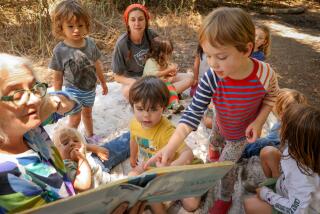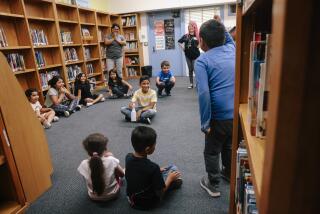Parenting : A Little Light Learning : Colleges and parks offer a wide variety of children’s classes for summer.
Sarah Kneeland of Winnetka can’t wait for the Pierce College summer catalogue to arrive in her mailbox. She loves to pore over the course descriptions, choosing the class that seems most appealing.
Will she try her hand at theater? Learn vaudeville? Take choreography lessons?
She usually ignores the ponderous academic stuff. After all, Sarah is only 5. And besides, it’s summer. The three R’s can wait till September.
For a change, how about three S’s: surfing, swimming and singing? Or P’s--puppet-making, piano-playing and puppy-training? Or M’s--modeling, map-reading and magic?
Parents seeking fun, creative and reasonably priced summer classes for children need look no further than the local park or college extension program. This season’s lineup includes a vast array of interesting and even downright wacky programs that teach kids--from about age 4 up--everything from forecasting weather to building a bug zoo.
“The courses offer kids an opportunity to dabble, explore and be enriched--without making a full commitment,” said Sarah’s mother, Ellen Fleischmann. “It’s a smorgasbord approach, which works for young children who have a short attention span. And Sarah gets a kick out of telling people she goes to college.”
Such summer offerings are especially welcome now that many cash-poor schools have all but dropped elective subjects such as art, music and drama from their curricula.
Barbara Bell of San Fernando, for example, is disappointed at the lack of serious art classes at the private elementary school her 10-year-old daughter, Dominique, attends. She fills in the gap by enrolling the girl in a six-week “Cartooning for Kids” class taught at Learning Tree University by a professional illustrator.
“Ever since she was big enough to hold a pencil or crayon, Dominique has considered herself the little artist,” Bell said. “Her school doesn’t emphasize art at all, and private classes are too expensive. But she is having a great time in this cartooning class.”
Extension courses, which usually meet once weekly for four to six weeks, tend to be less structured and have fewer students than traditional school classrooms, so students have ample opportunity for hands-on involvement and personalized attention.
“And the people who teach the classes are experts in their fields,” said Cindy Lieberman, program specialist at Pierce College Extension, “so students get the benefit of learning from someone who really loves their craft.”
Non-traditional classes can also pinpoint a child’s untapped talent or undiscovered interest, Lieberman added.
“The back-to-the-basics movement may help a kid be a better reader,” she said, “but in summer maybe they’d rather be a puppeteer. Or a magician. This is an inexpensive way to introduce kids to a lot of different subjects.”
By expanding their world and mastering new skills, kids also get a boost in self-esteem, according to Carol Finkle, recreation program coordinator at the Creative Arts Center in Burbank, which offers drawing, painting, sculpture and clay classes, all taught by working artists.
“I see things like art, music and dance as natural ways to develop a child’s self-image,” she said. “Only a few kids will get an A in arithmetic, but everybody can create something. Our main purpose is to tap into the kids’ creativity and give them an opportunity to do what they want--not what they have--to do.”
And after all, it is summer.






